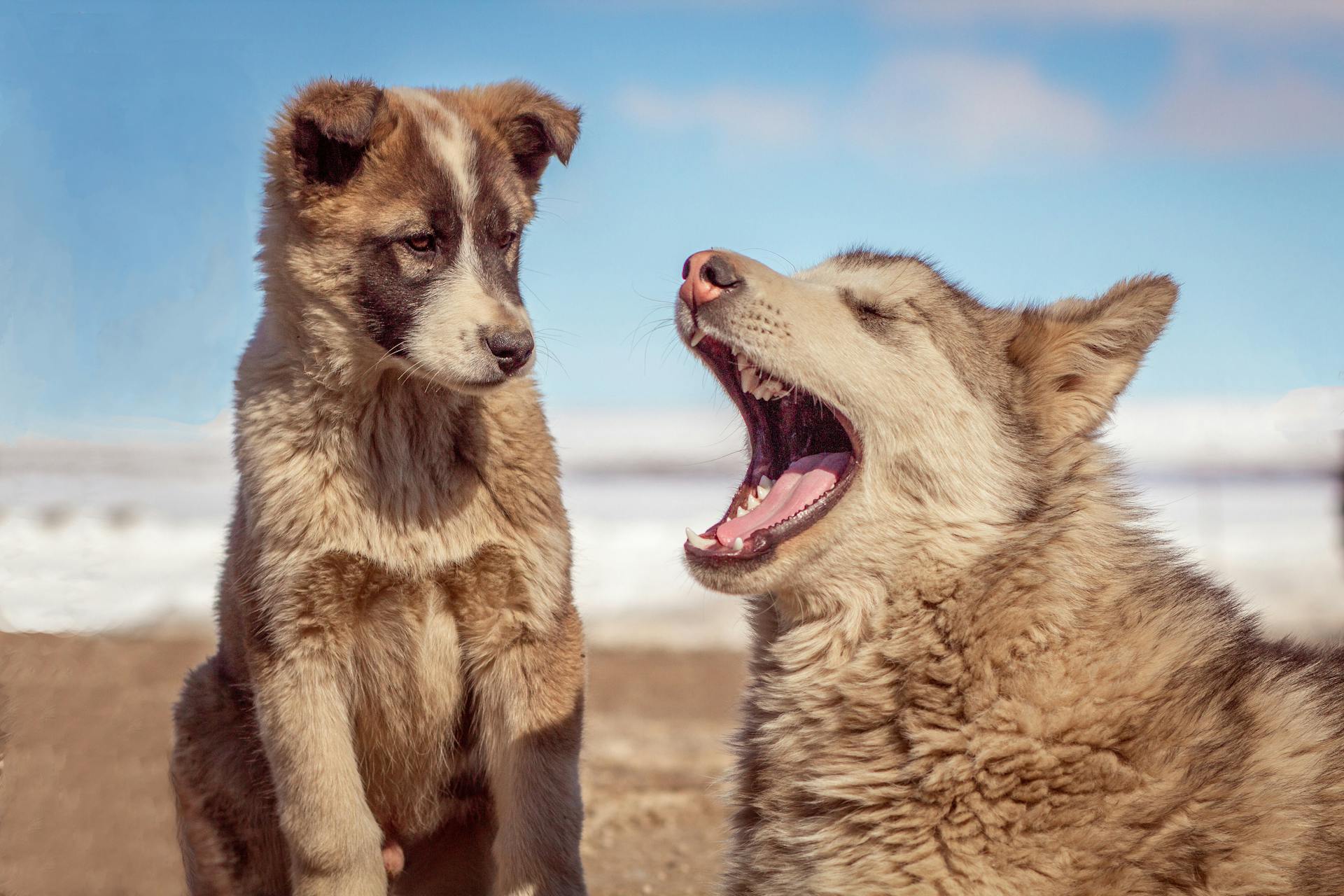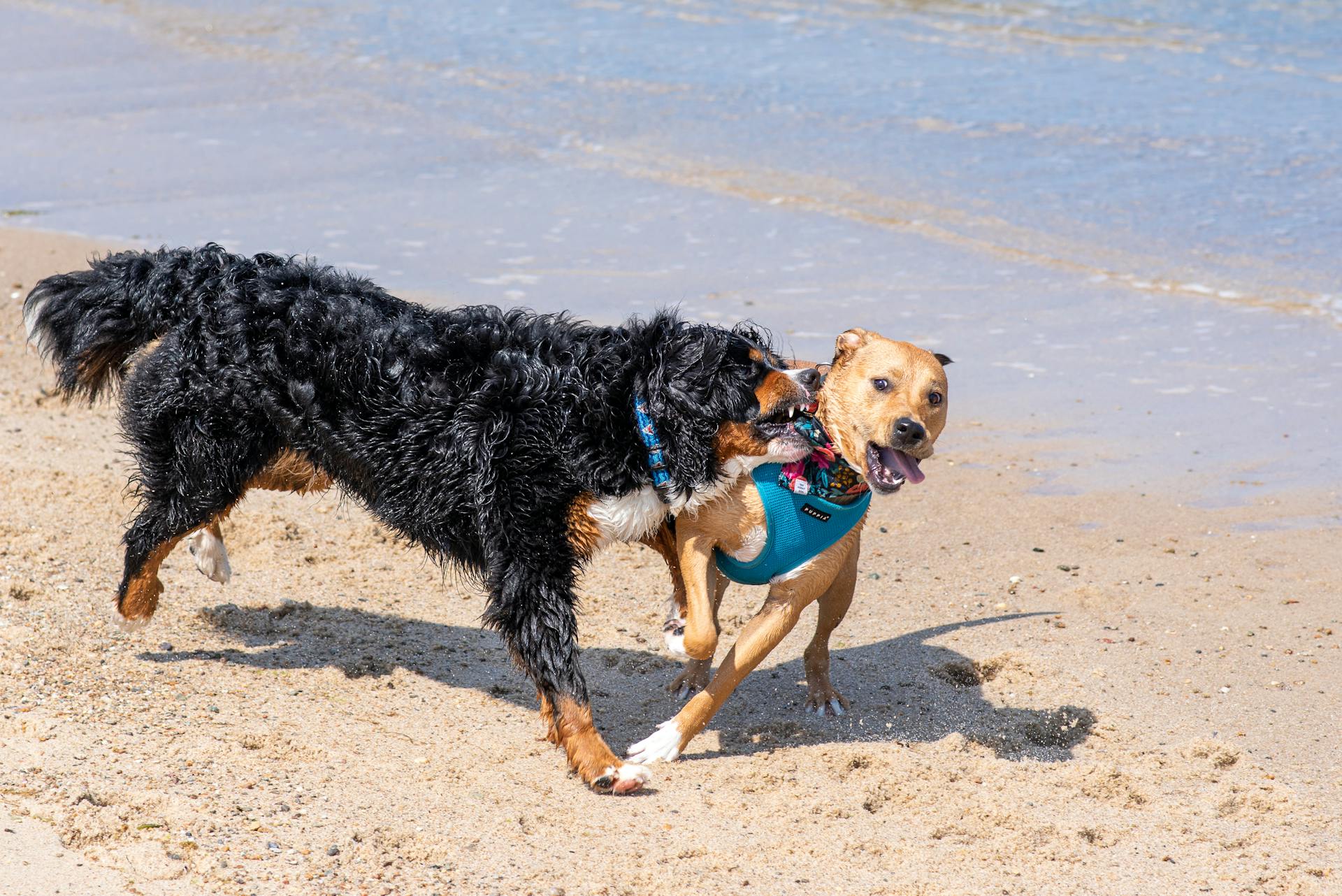
Dogs can have meat as part of a balanced diet, but it's essential to choose the right types and amounts.
Some meats are more suitable for dogs than others, such as chicken, beef, and fish, which are high in protein and low in fat. These meats can be a great addition to a dog's diet.
However, it's crucial to avoid giving your dog meat that's high in fat, salt, and preservatives, like processed meats and sausages. These can be detrimental to their health.
Feeding your dog a small amount of meat, about 10% of their daily calorie intake, is a good starting point.
Take a look at this: Dog Meats
Diet Types and Requirements
Dogs require a balanced diet that includes meat and plant foods. A diet consisting solely of meat products will not meet all of your dog's dietary requirements.
Dogs are omnivores, meaning they can eat both plant and animal matter. They have a shorter gastrointestinal tract compared to other omnivores and herbivores, and their digestive system is designed to help them digest raw meat quickly and efficiently.
Some scientists classify dogs as carnivores, but most veterinarians agree that dogs have adapted to eat a more complex diet than their wolf ancestors. Dogs produce amylase in much greater quantities than wolves, enabling them to digest foods other than meat.
A balanced diet for dogs can be achieved through a variety of methods, including commercially prepared raw diets or properly formulated homemade diets. These diets should include a variety of ingredients, such as bones, organ meats, essential fatty acids, and whole foods, to supply vitamins and minerals.
Here are some key dietary requirements for dogs:
- Essential amino acids
- Proteins that provide more value than others
- Variety of ingredients, including bones, organ meats, essential fatty acids, and whole foods
- Calcium and other essential minerals
Carnivore or Omnivore?
Gray wolves are definitely carnivores, capable of consuming up to 20 pounds of meat in one meal.
Their diet consists mainly of large-hoofed mammals like deer, elk, bison, and moose. They also hunt smaller mammals like beavers, rodents, and hares.
Dogs, on the other hand, are direct descendants of gray wolves, but their digestive system has adapted to allow them to eat a more complex diet. This is because they produce amylase in much greater quantities than wolves, enabling them to digest foods other than meat.
Some scientists classify dogs as omnivores, while others identify them as carnivores due to their long canine teeth and shorter gastrointestinal tracts compared to other omnivores and herbivores.
Dogs have a unique digestive system that allows them to digest a diet rich in starches, something wolves can't do. This is because they produce amylase in their saliva, but not in their stomach, which is different from other omnivores.
Whether dogs are classified as carnivores or omnivores, most veterinarians agree that their digestive system has adapted to allow them to eat a more complex diet than that of the wolf.
Balanced Diets
A balanced diet is crucial for your dog's overall health and well-being. A balanced diet that meets a dog's nutritional requirements includes meat and plant foods, provided the diet is made up of high-quality ingredients and includes the necessary proteins and fats.
Feeding a dog a diet consisting solely of meat products will not meet all of their dietary requirements. Meat does provide all of the essential amino acids, but a diet of only meat is not sufficient.
For another approach, see: Do Dogs Go through Phases of Not Eating
A dog's digestive system is designed to help them digest raw meat quickly and efficiently. Their GI system is shorter than a human's, and they have stronger stomach acids that help break down foods.
To ensure a balanced diet, it's essential to include a variety of foods in your dog's meals. This includes bones, organ meats, essential fatty acids, and whole foods to supply vitamins and minerals.
Here are some essential nutrients that your dog needs:
- Essential amino acids
- Proteins
- Fats
- Vitamins
- Minerals
A dog's nutritional needs have evolved with the species, and they are capable of digesting starchy foods through increased amylase secretion. However, it's still essential to provide a balanced diet that meets their nutritional requirements.
Cost of a Diet
You can save money by buying meat at a local abbatoir, butcher or farm, and look for cheaper cuts of meat that will provide just as much nutrition.
Feeding a raw diet may be less costly than you think, especially if you prepare his food yourself.

Dogs don't need filet mignon to have a healthy diet, and they're not squeamish about icky-looking squishy organs like liver or brain!
Your dog will likely be much healthier on a raw meat diet, which means you'll save money on vet visits.
Chewing on raw meaty bones helps provide the minerals and other nutrients necessary for strong bones and muscle development.
Benefits and Risks of Meat in Dog Diet
Dogs require a balanced diet that includes meat and plant foods to meet their nutritional needs.
A diet consisting solely of meat products won't meet all of your dog's dietary requirements.
Feeding dogs predominantly meat or an exclusive hamburger and rice diet can induce calcium deficiency and secondary hyperparathyroidism.
Dogs need certain essential amino acids in their diets, and some proteins provide more value than others.
Raw meat diets can be beneficial for dogs, producing a softer, shinier coat due to the high levels of vitamin E and zinc.
However, most dog kibble adds vitamin E and zinc to the formula to achieve the same result.
A study found that replacing canned dog food with beef oxtail removed over 30% of dental calculus in dogs within 24 hours.
Raw meat diets can improve digestion, with raw food taking only one or two hours to digest compared to kibble's seven to nine hours.
Feeding a raw diet can also help maintain lean mass and healthy weight in dogs.
Raw meat diets can be balanced to meet your dog's complete nutritional needs, but require variety in meals to provide all the necessary nutrients.
Dogs fed a raw diet need to include bones, organ meats, essential fatty acids, and whole foods to supply vitamins and minerals.
Feeding a raw meat diet can be as simple as thawing a frozen patty and putting it in your dog's bowl.
Raw meat is what your dog's body is built to eat, and can provide all the nutrients they need to thrive.
However, uncooked meat can harbor harmful bacteria such as salmonella, E. coli, and Listeria, which can cause foodborne illnesses in dogs.
Related reading: Can You Hurt a Dog's Feelings?
How to Prepare
Preparing meat for your dog is easier than you think. You can buy pre-made frozen raw diet or freeze-dried raw food that just needs rehydrating in water or broth.
Cut the meat into bite-sized pieces or opt for ground options that are easier for your pooch to chew and digest. This makes mealtime a breeze for both you and your dog.
Feeding raw meat doesn't have to be complicated, and it's no more time consuming than shopping for yourself. You can even use DIY raw recipes that are complete and balanced.
To minimize the risk of bacterial infections, it's best to opt for cooked meat instead of raw. This is especially true if you're new to feeding your dog a meat-based diet.
Worth a look: Pros and Cons of Feeding Dogs Human Food
Health and Safety Considerations
When handling raw meat for your dog, it's essential to prioritize quality and hygiene. Buy fresh meat that looks and smells good, and avoid giving your dog meat that's been sitting out for too long.
Freezing raw meat until ready for use, keeping it separate from cooked food, and washing your hands before and after handling it are all recommended practices to reduce the risk of bacterial infections.
If your dog eats raw meat from the grocery store, they'll likely be fine, but if you notice any unusual symptoms, contact your vet immediately. Some pet insurance plans cover emergency and specialty care, so it's worth checking if you have one.
To minimize the risk of illness, make sure to clean preparation surfaces and food bowls with soap and hot water after handling raw meat.
Here are some key steps to follow for safe handling of raw meat:
- Freeze raw meat until ready for use
- Keep raw meat separate from cooked food
- Clean preparation surfaces and food bowls with soap and hot water
- Wash your hands before and after handling the meat
Dogs Getting Sick from Eating
It's rare for dogs to die from eating raw meat, but it's essential to take the potential health risks seriously.
Raw meat can contain bacteria like salmonella, which can cause infections. However, your dog's digestive system is built to handle bacteria in the gut without a problem.
If your dog eats raw meat, it's crucial to exercise proper cleaning procedures to prevent the risk of bacterial infections. This includes freezing the raw meat until ready for use, keeping it separate from cooked food, and washing your hands before and after handling the meat.
You can also reduce the risk of contamination by practicing sensible hygiene, such as cleaning utensils, dishes, and surfaces used to prepare your dog's food.
Here are some essential steps to follow if your dog eats raw meat:
- Freeze the raw meat until ready for use
- Keep the raw meat separate from cooked food
- Clean preparation surfaces and food bowls with soap and hot water
- Wash your hands before and after handling the meat
If you notice any signs of illness in your dog after consuming raw meat, contact your vet immediately.
Does Make Aggressive?
Feeding a raw meat diet to your dog won't make him aggressive. This is a common myth that's based purely on fear.
Research shows that raw diets actually improve your dog's mood and behavior. This means you can expect a happier, healthier pup on a well-balanced raw diet.
It's essential to teach your dog good manners and polite behavior around food, regardless of the diet. This includes not getting possessive and wanting to share.
With proper training, your dog can enjoy a raw meat diet without becoming aggressive.
You might enjoy: Aggressive Dogs
Special Considerations

Dogs can have meat, but it's essential to consider their individual needs and health status.
Some dogs are prone to food allergies or sensitivities, making it crucial to introduce new protein sources slowly and under veterinary guidance.
Feeding high-quality meat can help support a dog's overall health, but excessive consumption can lead to nutrient imbalances.
Dogs with kidney disease may require a more limited protein intake to prevent further strain on their kidneys.
A balanced diet that includes a variety of protein sources can help support a dog's immune system and overall well-being.
Dogs with certain health conditions, such as pancreatitis, may require a diet that is low in fat and high in fiber.
Some breeds, like Greyhounds and Whippets, are prone to bloat, making it essential to feed them multiple small meals throughout the day.
See what others are reading: Food for Dogs with High Blood Pressure
Frequently Asked Questions
What meat should a dog not eat?
Dogs should avoid fatty meats like hot dogs, bacon, and fried chicken, which can cause stomach upset and pancreatitis. Limiting these foods can help keep your dog's digestive system healthy
Sources
- https://www.akc.org/expert-advice/nutrition/do-dogs-need-meat-in-their-diets/
- https://www.akc.org/expert-advice/nutrition/human-foods-dogs-can-and-cant-eat/
- https://www.pawlicy.com/blog/can-dogs-eat-raw-meat/
- https://www.dogsnaturallymagazine.com/raw-meat-diet-for-dogs-7-myths-you-wont-believe/
- https://www.petmd.com/dog/nutrition/can-dogs-eat-raw-meat
Featured Images: pexels.com


